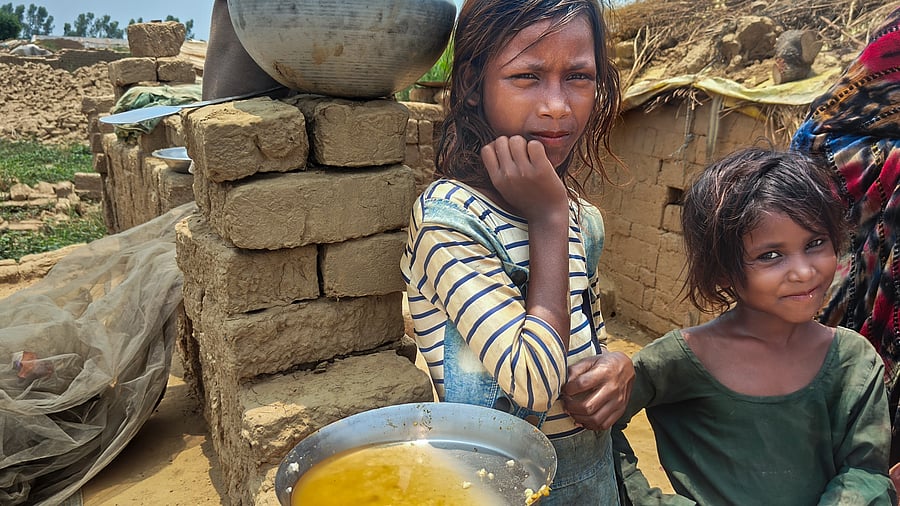
Children who work with their families at a brick kiln, in Aligarh district, Uttar Pradesh, Wednesday, May 28, 2025.
Credit: PTI Photo
Bulandshahr/Aligarh: In the scorching May heat, 12-year-old Rajni cradles her infant sister while stirring watery dal simmering in a soot-blackened aluminium pot outside her hut in Uttar Pradesh's Aligarh district.
Just as the thin lentils begin to look ready, she pours more water into the pot in a bid to stretch the modest meal, which otherwise wouldn't be enough to feed her family of eight.
When asked how it tastes, Rajni responds in a defensive tone: "This is not bad... It's better than no food." Fruits, she adds, are a rare treat -- usually available only when a local farmer tosses away overripe leftovers.
"This year, I ate a lot of mangoes," she said with a grin, referring to tapkas, the ripe mangoes that fall from trees that she and her friends were allowed to collect.
Rajni's family is one among thousands of seasonal migrants who travel each year to work in the sprawling brick kilns of western Uttar Pradesh.
But while the kilns promise income, the real cost is borne by children like Rajni, who grow up without education, adequate food, or healthcare and are caught in a cycle of generational poverty and invisible labour.
In 2021, data submitted by the government to Parliament suggested that there are 1.74 crore workers in registered brick kilns, while independent research has shown that 20 per cent of this workforce consists of child labourers.
"Therefore, it can be reasonably presumed that approximately 35 lakh children are working in brick kilns, with the number likely higher in illegal kilns," said Bhuwan Ribhu, a child rights activist who founded Just Rights for Children.
Most of the families' movement, dictated by the kiln season, spans eight to nine months a year. With no permanent address and no local documentation, the children are often excluded from even the most basic rights,".
Ten-year-old Neeraj, for instance, spends his days hauling lumps of dried mud in a wooden pan.
"I can't go to school because my father says we have come here as one unit and all need to work. If I get a chance to go to school, I would study hard and become an officer," he said.
His mother adds, "Each one of us, including the children, has a role in this industry." Children are typically assigned so-called "lighter tasks," such as fetching water, helping to mould bricks, or carrying half-baked clay, but the physical toll is visible in their frail, malnourished bodies.
"For every rupee a worker earns, nearly 25 paise goes to the agent and brick kiln owners are in direct touch with the agents, so we get just 75 per cent of the earnings, which comes to around Rs 400 per day for a family," explained Suresh, a brick kiln worker.
Elaborating further, Ramesh Shrivastav, general secretary of the Mazdoor Adhikar Manch, said the system is designed to exploit the vulnerability of the migrant workers and their children and keep them indebted.
"For kiln owners, local labourers are a risk because they can protest against exploitation as they have their community here. This, however, is not the case with migrant workers, so kiln owners only hire them as they are vulnerable and less likely to resist exploitation. Moreover, as migrant workers' children don't attend school like the locals, the kiln owners get extra hands," he said.
Among the 20-odd children PTI spoke to across kiln sites in Aligarh and Bulandshahr, none were currently enrolled in school. Only two had ever attended school, and that too briefly, as their parents began migrating seasonally.
"My sister and I studied till class 5 when our parents used to find work in our village. That was back in 2018," said Naresh, a 14-year-old boy.
Despite the Right to Education Act mandating free and compulsory education for all children aged 6 to 14, migrant children remain excluded. The government has tried to bridge this gap through the Poshan Tracker, linking anganwadis to migrant families, but the implementation is patchy.
While most parents were unaware of the scheme, the prospect of sending their children away from the worksite was a deal-breaker.
"Who will fetch water or help us mould bricks if they go to school? We came here to earn, not to study. That will come later, maybe for their children," said Munni Devi, a mother of five.
Meanwhile, local anganwadi workers say they often hesitate to enrol children without documents like Aadhar.
"While Aadhaar now allows for easier enrolment, many children still don't come because of the distance. Most anganwadis are located within villages, while many families live on the outskirts. There's also fear that showing up at an anganwadi might draw attention to the fact that the children aren't attending school," said an anganwadi worker in Bulandshahr, speaking on condition of anonymity.
When PTI reached out to the brick kiln owners, they denied employing children, saying the kids only "accompany" their families.
"It is up to the parents to decide whether they want to send their children to school or keep them here... how can we interfere?" a kiln owner said.
Rights activists, however, termed it as an excuse for systemic exploitation.
"Children working alongside parents is normalised, but this is not helpful; it's hidden labour, and it violates their rights," said Nirmal Gorana, convenor of the National Campaign Committee for the Eradication of Bonded Labour.
According to a local official, the seasonal nature of the work also makes oversight difficult, as the workers come in October and leave by June before the monsoon.
"So, keeping track of their movement and exploitation becomes tough," the district official told PTI.